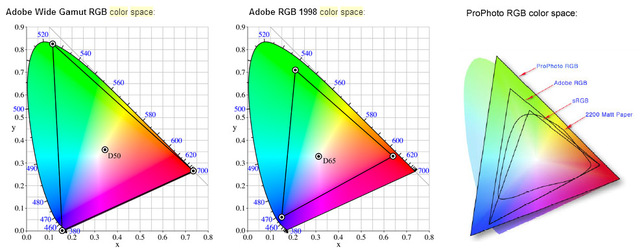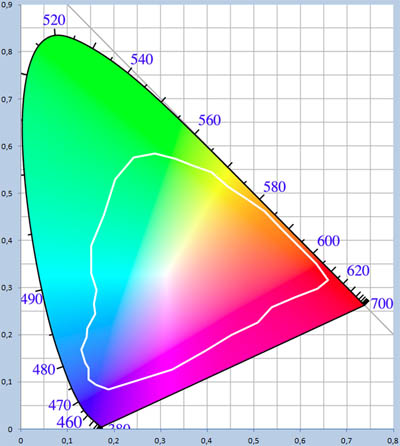Briefly about the screens

These are the parameters that images on modern tablets should have so that marketers can speak with a clear conscience about a realistic picture.
Resolution
The resolution is described in some detail here: About the size of the pixel, screen and element , so there will be only a small squeeze below:
Human vision has a certain resolution, expressed in minutes of the arc. On average, in an adult, it is ~ 0.3 minutes of arc. Thus, the required pixel size is calculated by the following formula:
p = 2 *d * Tan(a/2)
where
p = pixel size
d = distance in millimeters
a = resolution angle in radians A
simple calculation gives 720ppi for a tablet at a distance of 305mm and a bit more for a phone.
Current generic tablets - ~ 200ppi
Color
The color on the monitor is currently encoded with three coordinates R, G and B, which indicate a point in the so-called color space. It should be understood that there is a direct color gamut, i.e. what colors generally fall on the picture, and the color depth, which determines the "number of shades." For ease of understanding, we can say that the color gamut is the triangle in the picture below, and the color depth / bitness is the “resolution” of this triangle. The cone-shaped substrate is the CIE 1931 XYZ space, a reference color model defined in a strict mathematical sense.

Read more about color spaces .
It should be noted here that there is some cunning in the picture for the post: although a person really sees all the colors indicated in CIE 1931, however, in the real world, the final colors obtained by mixing diffuse, reflective and other components of the surface are much smaller. Dr. Michael R. Pointer did a tremendous job of creating irregular color gamut.

Such coverage is not described by three coordinates without significant redundancy in the form of “imaginary colors”, because a triangle of the required shape would go beyond CIE 1931. It is funny that Pointer's Gamut areas that fall outside the majority of the “triangles” are quite common in real life. In addition, the full coverage of CIE 1931 would give significantly more opportunities for both artists and interface designers.
More on Pointer's Gamut Current Generic Tablets
- ~ 41% CIE 1931 Coverage
Frames per second
There is a fairly popular misconception that a person can see no more than 30 frames per second, and that is why films and television use 24 \ 30 frames per second, and this is enough. In fact, this is wrong on several sides at once. Firstly, a person does not see at all “frames per second” - information is not processed discretely, but in several “streams”, which include recognition of individual objects, directions of movements, lines, colors, and so on, for which individual parts of the visual center are responsible . Secondly, films use 24 frames only because this is the minimum necessary speed so that when using motion blur, a person begins to perceive a series of pictures as movement, although remaining fully able to notice twitching even at a conscious level. Thirdly,


The US Air Force used a very simple test to determine the speed of a visual reaction to small changes in light. The experiment was a series of pictures of airplanes blinking on a monitor in a dark room every 1 \ 220 seconds. Pilots were quite able to “see” the post-image and even determine the model of the aircraft. Such data prove not only the fact that a person can distinguish 1 picture in 1 \ 220 seconds, but it is also very likely to interpret the video even with a large FPS.
Current generic - ~ 40 FPS interface and games \ 24 FPS video
The article aims not only to enlighten those who are interested, but also to console technofascists and visualophiles, who were convinced that the picture had reached the ideal and there would be no need to update the hardware soon. It is safe to say that the implementation of such large PPI, color, and FPS will require not only completely new types of screens, but will also significantly increase the load on the GPU.
